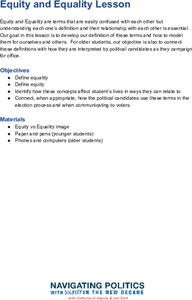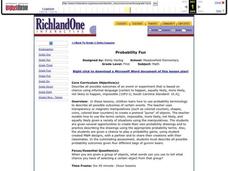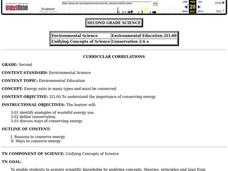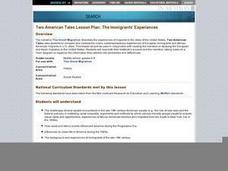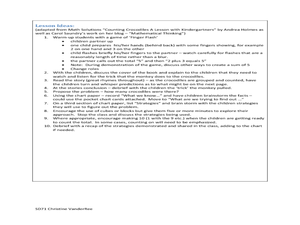Cultures of Dignity
Equity and Equality Lesson
Equality does not equal equity and this lesson explains why. Class members compare two images--one labeled "Equality" and the other "Equity." Using the provided discussion questions, they then develop definitions that distinguish between...
Curated OER
Grouping and Counting Items
Students create equal groups of objects. In this math lesson, students create predictions as to how many objects they can get in each equal group. Additionally, students explore and record findings.
IRISS
Exploring Self-Esteem 1: What Is Self-Esteem?
Adolescents explore self-esteem and the various factors that influence a person's sense of self in this four-part lesson series. Through a combination of whole class instruction, small group discussions, and independent work,...
Laboratory for Atmospheric and Space Physics
Planetary Distances on the Playground
There's no need to stay inside; get out of the classroom and create a scaled map of the solar system on your playground field! In collaborative groups, scholars identify the distance between the sun and other planets, place planet...
Curated OER
May the Force Be With You
Students work in groups, they investigate how different forces act upon objects and how this information can be used in their day-to-day lives. They wrap the rubber band around the book. Students place the bo.ok and ruler on top of a...
Colorado State University
Why Does the Wind Blow?
Without wind, the weather man wouldn't have much to talk about! Blow away your junior meteorologists with a creative demonstration of how wind works. The activity uses an empty soda bottle and compressible Styrofoam peanuts to illustrate...
Curated OER
Probability Fun
First graders use probability terminology to describe all possible outcomes of certain events. In this probability lesson, 1st graders use counters to create a pretend "purse" of objects. Students create their own probability...
Curated OER
Investigating Motion
Students explore types of motion. In this motion experiment, students observe how objects move. Students work in small groups to discover the laws of motion.
Curated OER
Physical Differences
Students read the book We Can Do It! and discuss how we are all physically different. In this physically different lesson plan, students read the book, discuss their differences, and participate in a smelling and touching activity to see...
Curated OER
Energy Conservation
Class is divided into groups of 2-4 students. They then are given a list of 36 items that are found in our homes and which use electricity. They are going to pretend that because of an energy shortage, they have to pick only twelve items...
Curated OER
The Great Migration: Two American Tales
Students compare and contrast experiences of European immigrants and African American migrants in U.S. cities. After examining the topic, they write essays evaluating the differences and similarities of the groups' experiences.
Curated OER
Woman Holding Plum Blossoms
Learners contrast and compare the definition of beauty in Tang dynasty China with that of America today in this high school Social Studies lesson. The lesson concludes with a small group activity.
Curated OER
Lu-Lu
First graders practice their counting skills while playing a Hawaiian game called Lu-Lu. Lu-Lu is a Hawaiian counting game. It is played with four stones. Each stone is divided into four equal sections and dots are placed in the...
Cornell University
Buoyancy
Swimmers know to float by turning their bodies horizontally rather than vertically, but why does that make a difference? In an interesting lesson, scholars explore buoyancy and the properties of air and water. They test cups to see which...
American Chemical Society
What is Density?
Density: the reason a giant pumpkin will float, but a tiny cranberry won't. Lesson begins with a demonstration of two of the same-sized cubes having different densities. Then pupils take eight cubes, each of the same size, and have to...
Kenan Fellows
The Newton Challenge
Make Newton proud. Scholars apply their understanding of forces and energy to an engineering design challenge. They learn about simple machines, create a presentation on Newton's laws, and develop a balloon-powered car.
Curated OER
Good Health
Students complete a unit with cross-curricular activities to learn about a healthy body and maintaining their health. In this health lesson, students complete 8 lessons to learn about good health, a healthy diet, healthy foods, healthy...
Curated OER
Tessellations
Young scholars identify and construct figures that tessellate. They investigate which regular polygons tessellate and how to modify them to make other tessellating figures. Students explore how naturally occurring tessellations have...
Curated OER
Book Title: Counting Crocodiles by Judy Sierra
Students explore number sequence in a variety of activities. In this number practice lesson, students play a game of finger flash and read the book Counting Crocodiles. Students discuss the counting elements in the book and chart the...
Curated OER
Challenging Images
Young scholars demonstrate the meaning of self-esteem and individuality. In this character education lesson, students discuss the meaning of self-esteem and self-image. Young scholars are divided into small groups and are...
Curated OER
How Light Moves
Students study the movement of light. For this light lesson, students work in groups to participate in a light and shadow walk around their neighborhood. Students brainstorm rules for light movement and watch videos about light travel,...
Curated OER
Matter
Young scholars complete a unit of activities to learn about states of matter and how to measure matter. In this matter lesson, students complete 8 lessons to learn about matter, its states, and how to measure matter.
